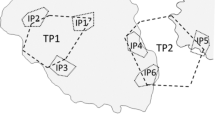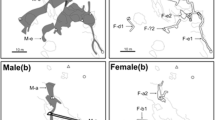Abstract
Social structure of the protogynous angelfish, Centropyge ferrugatus, was examined on the coral reefs of Sesoko Island, Okinawa, Japan. Each individual male monopolized a harem of 1-6 females. Harems could be categorized as linear-type or branching-type based upon spatial and dominance relationships among the females. A linear harem consisted of different-sized females whose home ranges overlapped each other with a linear dominance order based on body size. Branching harems were composed of two linear sub-groups dividing a male's territory. Females of similar size did not have overlapping home ranges, which resulted in branching harems. These two systems appear to be a result of competition for opportunities of sex change, as only the largest fish of a harem (or a sub-group) can become a male. Comparison of the harem structures of some reef fishes suggests that the two harem structures may occur broadly in protogynous haremic fishes.
Similar content being viewed by others
References cited
Aldenhoven, J.M. 1986. Different reproductive strategies in a sex-changing coral reef fish Centropyge bicolor (Pomacanthidae). Aust. J. Mar. Freshw. Res. 37: 353–360.
Baird, T.A. 1988. Female and male territoriality and mating system of the sand tilefish, Malacanthus plumieri. Env. Biol. Fish. 22: 101–116.
Donaldson, T.J. 1990. Reproductive behavior and social organization of some Pacific hawkfishes (Cirrhitidae). Japan. J. Ichthyol. 36: 439–458.
Hourigan, T.F. 1986. A comparison of haremic social systems in two reef fishes. pp. 23–28. In: L.C. Drickamer (ed.) Behavioral Ecology and Population Biology, Readings from the 19th International Ethology Conference, Privat, Toulouse.
Kuwamura, T. 1984. Social structure of the protogynous fish Labroides dimidiatus. Publ. Seto Mar. Biol. Lab. 29: 117–177.
Kuwamura, T. 1988. Parental care and social systems in fishes. Kaimeisha, Tokyo. 136 pp. (in Japanese).
Lutnesky, M.M.F. 1994. Density-dependent protogynous sex change in territorial-haremic fishes: models and evidence. Behav. Ecol. 5: 375–383.
Moyer, J.T. 1984. Reproductive behavior and social organization of the pomacanthid fish Genicanthus lamarck at Mactan Island, Philippines. Copeia 1984: 194–200.
Moyer, J.T. 1990. Social and reproductive behavior of Chaeto-dontoplus mesoleucus (Pomacanthidae) at Bantayan Island, Philippines, with notes on pomacanthid relationships. Japan. J. Ichthyol. 36: 459–467.
Moyer, J.T. 1991. Comparative mating strategies of labrid fishes. The Watanabe Ichthyological Institute Monograph 1. 90 pp.
Moyer, J.T. & A. Nakazono. 1978. Population structure, reproductive behavior and protogynous hermaphroditism in the angelfish Centropyge interruptus at Miyake-jima, Japan. Japan. J. Ichthyol. 25: 25–39.
Moyer, J.T. & M.J. Zaiser. 1984. Early sex change: a possible mating strategy of Centropyge angelfishes (Pisces: Pomacanthidae). J. Ethol. 2: 63–67.
Nakazono, A., H. Nakatani & H. Tsukahara. 1985. Reproductive ecology of the Japanese reef fish, Parapercis snyderi. Proc. 5th Int. Coral Reef Congress 5: 355–360.
Nemtzov, S.C. 1985. Social control of sex change in the Red Sea razorfish Xyrichtys pentadactylus (Teleostei, Labridae). Env. Biol. Fish. 14: 199–211.
Robertson, D.R. 1972. Social control of sex reversal in a coral-reef fish. Science 177: 1007–1009.
Robertson, D.R. & R.R. Warner. 1978. Sexual patterns in the labroid fishes of the Western Caribbean, II: The parrotfishes (Scaridae). Smithson. Contrib. Zool. 255: 1–26.
Sakai, Y. 1996a. Alternative spawning tactics of female angelfish according to two different contexts of sex change. Behav. Ecol. (in press).
Sakai, Y. 1996b. Fecundity of female angelfish, Centropyge ferrugatus, independent of body size: field collection of spawned eggs. Ichthyol. Res. 43: 186–189.
Sakai, Y. & M. Kohda. 1995a. Anti-egg predator behaviors of the small angelfish Centropyge ferrugatus (Pomacanthidae). Env. Biol. Fish. 43: 401–405.
Sakai, Y. & M. Kohda. 1995b. Foraging by mixed-species groups involving a small angelfish, Centropyge ferrugatus (Pomacanthidae). Japan. J. Ichthyol. 41: 429–435.
Sano, M., M. Shimizu & Y. Nose. 1987. Long-term effects of destruction of hermatypic corals by Acanthaster planci infestation on reef fish communities at Iriomote Island, Japan. Mar. Ecol. Prog. Ser. 37: 191–199.
Shapiro, D.Y. 1979. Social behavior, group structure, and the control of sex reversal in hermaphroditic fish. pp. 43–102. In: J.S. Rosenblatt, R.A. Hinde, C. Beer & M.C. Busnel (ed.) Advances in the Study of Behavior 10, Academic Press, Berlin.
Thresher, R.E. 1984. Reproduction in reef fishes. T.F.H. Publications, Neptune City. 399 pp.
Warner, R.R. & D.R. Robertson. 1978. Sexual patterns in the labroid fishes of the Western Caribbean, I: The wrasses (Labridae). Smithson. Contrib. Zool. 254: 1–27.
Author information
Authors and Affiliations
Additional information
c/o Prof. T. Kuwamura
Rights and permissions
About this article
Cite this article
Sakai, Y., Kohda, M. Harem structure of the protogynous angelfish, Centropyge ferrugatus (Pomacanthidae). Environmental Biology of Fishes 49, 333–339 (1997). https://doi.org/10.1023/A:1007313501829
Issue Date:
DOI: https://doi.org/10.1023/A:1007313501829




